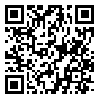
Journal of Modern Research Physics

Volume 1, Issue 1 ( Autumn & Winter 2017)
JMRPh 2017, 1(1): 31-40 |
Back to browse issues page
Download citation:
BibTeX | RIS | EndNote | Medlars | ProCite | Reference Manager | RefWorks
Send citation to:



BibTeX | RIS | EndNote | Medlars | ProCite | Reference Manager | RefWorks
Send citation to:
zargar shoushtari M, rostami B, farbod M. Fabrication and Investigation of Superconducting Properties of SmBa2Cu3O7-δ, Doped with Al2O3 Nanoparticles. JMRPh 2017; 1 (1) :31-40
URL: http://jmrph.khu.ac.ir/article-1-27-en.html
URL: http://jmrph.khu.ac.ir/article-1-27-en.html
Abstract: (2464 Views)
SmBa2Cu3O7-δ (SBCO) superconductor is synthesized through the solid state reaction method and also the alumina (γ-Al2O3) nanoparticles with the average size of 70 nm were made through the sol-gel self-combustion method and they were compared with the SIGMA Al2O3 nanoparticles. Then the SBCO superconductor was doped with different percentage of the alumina nanoparticles and its properties were studied and also the oxygen content of the samples was measured by iodometric titration. It was found that the oxygen content and critical temperature of the doped samples reduced. The study of resistivity versus temperature of the samples showed a semiconducting behavior in the normal state; i.e. by increasing the temperature, the resistivity decreased. The critical current density of 0.1 percent doped sample increased significantly, but it decreased by further doping. X-ray diffraction patterns of the doped samples showed that the alumina nanoparticles did not inter into the crystal structure of the superconductor. Also, a few peaks of the X-ray diffraction patterns of the doped samples were absent and the width of the peaks was broadened compared with the undoped sample. SEM images showed that the alumina nanoparticles spread on the surface of the grains and boundaries of the doped samples.
Type of Study: Research |
Subject:
Special
Received: 2017/10/25 | Accepted: 2017/10/25 | Published: 2017/10/25 | ePublished: 2017/10/25
Received: 2017/10/25 | Accepted: 2017/10/25 | Published: 2017/10/25 | ePublished: 2017/10/25
Send email to the article author
| Rights and permissions | |
 |
This work is licensed under a Creative Commons Attribution-NonCommercial 4.0 International License. |



